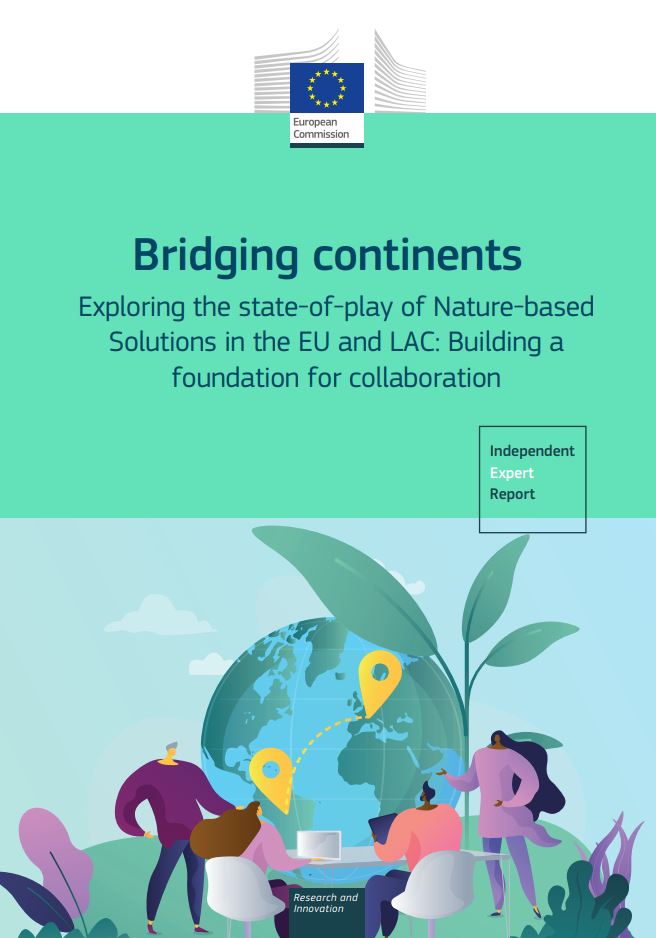Bridging Continents – Exploring the State-of-play of Nature-based Solutions in the EU and LAC
Building a foundation for collaboration
- Publication
- Citation
Burgos, N., Rizzi, D., & Davis, M. (2024). Bridging Continents. Exploring the state-of-play of Nature-based Solutions in the EU and LAC: Building a foundation for collaboration. European Commission, Directorate-General for Research and Innovation, Publications Office of the European Union.
The Publications Office of the European Union has released an Independent Expert Report titled "Bridging Continents: Exploring the State-of-Play of Nature-Based Solutions in the EU and LAC: Building a Foundation for Collaboration", which was co-authored by Natalia Burgos and McKenna Davis of Ecologic Institute and Daniela Rizzi. This report delves into the progress, challenges, and opportunities in implementing nature-based solutions (NbS) across the European Union (EU) and Latin America and the Caribbean (LAC).
Why this report matters
Cooperation in research and innovation between the EU and LAC is gaining momentum, with NbS emerging as a key focus. NbS are recognized for their potential to make significant contributions to global environment and development goals, such as the Kunming-Montreal Global Biodiversity Framework, the Paris Agreement, and the Sustainable Development Goals (SDGs). By addressing interconnected challenges like climate change, disaster risk, and biodiversity loss, NbS provide a pathway to sustainable development in both regions. Yet, information is scattered and difficult to identify across both regions. As collaboration between the EU and LAC could fast-track NbS implementation, aligning policy frameworks and unlocking new funding streams – this report fills a critical gap and presents an overview of the state-of-the art in both regions as a basis for identifying viable collaboration pathways around NbS.
Key highlights of the report
- Comprehensive overview of NbS in the EU and LAC
Dedicated chapters present the status of NbS in both regions, featuring key discussions on NbS strategies, notable initiatives, stakeholder engagement, and funding streams at various scales. - NbS case studies across diverse rural and urban landscapes
The report offers in-depth case studies from various ecosystems, from coastal zones to urban areas, each demonstrating how barriers were overcome and lessons learned, as well as policy instruments which have supported the NbS. - Policy framework overview
A comparative analysis reveals both successes and gaps in the policy frameworks of the EU and countries within the LAC region, offering pathways for enhanced policy integration and alignment. - Exploring NbS funding streams
Securing sustainable financing is critical. The report reviews public, private, and international cooperation funding options, identifying barriers to accessibility and suggesting solutions. - Knowledge sharing & grassroots Initiatives
Bottom-up initiatives driven by local communities are featured, highlighting how community knowledge and innovation are integral to successful NbS projects. - Pathways for collaboration
Building on identified barriers for NbS implementation (e.g. regulatory obstacles, funding limitations, and technical gaps) as well as enablers (e.g. supportive policies, strong partnerships, and cross-sector integration), the report outlines pathways for strengthening EU-LAC NbS collaboration. These include: joint research, policy integration, capacity-building, innovative financing, and knowledge exchange.
Strengthening EU-LAC Cooperation
Concrete steps are proposed to build a robust foundation for EU-LAC cooperation, leveraging shared challenges and strengths to accelerate NbS adoption and foster a nature-positive economy. The report will be officially launched at COP16 in Cali, Colombia, on 21 October 2024 at 15:30, during the session "Advancing Nature-based Solutions with Strategic Multilevel Governance" at the EU Pavilion (Blue Zone). The event is organized by the EU project Network Nature.
You can access the full report here. It's a must-read for policymakers, researchers, and practitioners committed to advancing sustainability through nature-based solutions.
Accompanying the report, a compact, 2-page summary from the European Commission summarises the most important findings.




